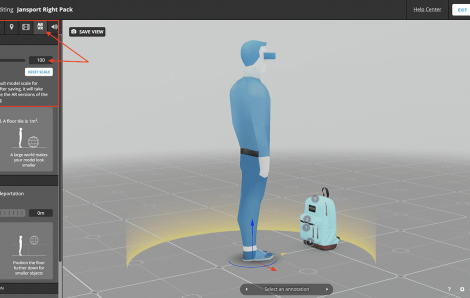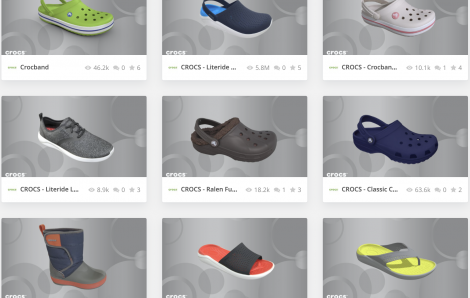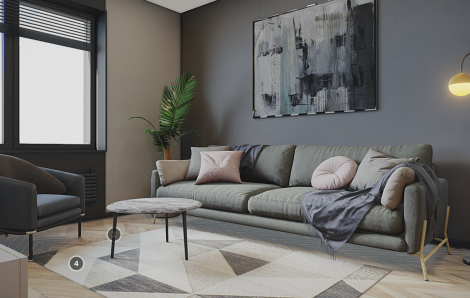The Methods to Create 3D Models
A typical conversation we have with our clients is about 3D content creation. Even though 3D content creation is becoming more and more democratized, much like video, we’re still talking about a form of media traditionally produced by expert artists.
While Sketchfab is not a creation tool, we have an extraordinarily rich and talented community of millions of 3D artists and professional agencies who have created and published millions of models.
You can buy 3D models directly from our store.
If you need help to create 3D models specific to your brand, visit our Sketchfab’s partners directory and reach out to one of our partners.
Read on to learn more about the different ways people are creating and capturing 3D models of their products.
3D modeling and 3D scanning: the two primary means of building 3D assets
3D modeling: building a model from scratch
3D modeling or CAD (Computer-aided design) refers to the creative process of building a model in three dimensions (known as x,y,z) using a dedicated software package like Maya, Houdini, Blender, Cinema 4D, or many others.
CAD has been used for years in many industries to create a database for manufacturing, to improve the quality of design and communications through documentation. As a result, most brands find that 3D content already exists in their manufacturing process.
We encourage you to reach back into your production pipeline to look for existing 3D content. We can then help you optimize your 3D assets so that they are web ready.
By way of example, Zodiac Nautic recently launched a 3D boat configurator using the Sketchfab API. Before greenlighting a new boat construction at Zodiac Nautic, it is modeled in 3D with materials to allow them to get a sense of what the real-world boat will look like.
Instead of producing all 3D models from scratch, Klaas Nienhuis, who developed the 3D configurator, reused these existing 3D models from the engineering pipeline and optimized them for use in a browser. This was a huge time and money saver. For more info, you can read our case study here.
Another great example of model optimization was undertaken for Schneider electric to showcase their technical products in 3D and create an interactive 3D product catalog. You can try an annotated and animated version of one of their products here.
Schneider explain how complex products work with 3D annotated models
3D scanning, an authentic rendition of a real object
3D scanning is sometimes referred to as ‘reality capture’ because it’s not based on interpretation by a 3D artist but is an authentic rendition. It’s the process of analyzing a real-world object with special software or hardware to collect data about its shape and appearance, and use those collected data to create a 3D model.
Different scanning techniques suit different subject matters but can sometimes be used in a combined workflow to construct a final 3D model.
Photogrammetry
Photogrammetry is a method for capturing an object or space in 3D by taking digital photographs of it from many different angles and processing this image set into a single asset using dedicated softwares.
This has become an increasingly common way to create 3D models, especially because you can capture the required imagery with a simple smartphone. Photogrammetry creates the most accurate representation of real world objects.
Great for: apparel, shoe, artwork, sculpture
Bad candidates: objects that reflect or filter light (transparent, shiny, metallic…)
Structured light scanning
This method uses a combination of calibrated hardware, often handheld, to project various patterns of light onto the subject and simultaneously measure the deformations in the pattern as it hits surfaces at different angles using synchronized cameras.
Great for: reverse engineering, high precision jobs, small to medium-sized subjects, people, components, food, clothing, artifacts
TetraVision digitized this small Lego block to check some critical quality parameters
Laser Scanning & LiDAR
Most commonly used in survey and building information modelling (BIM). Laser scanning or light detection and ranging (LiDAR) is a 3D scanning technique that works by firing thousands of laser beams from a central station, and then measuring the time it takes for each beam to bounce back off the in-range environment.
These individual measurements are combined to create what is known as a ‘point cloud’ – a 3D representation of where each laser beam struck a surface around the scanning station that can exist on its own or easily be converted into a surface model.
Great for: buildings, landscapes, abstract art, example collection
Now that you have 3D content, it’s time to share it!
Now that you have 3D content, it’s time to publish your assets. Sketchfab’s 3D player is built with webGL technology which makes it compatible with all devices and browsers without the need for any plugin or extension.
Embedding is simple – just a matter of uploading your model to Sketchfab and then embedding anywhere on the web: your brand website, blog, press articles, advertising campaigns or across social channels.
We also have a very robust API with which you can control the Sketchfab viewer with javaScript (moving the camera, taking screenshots and much more). Feel free to review our API documentation.





